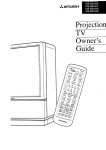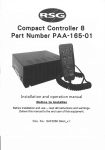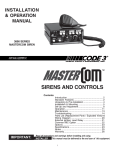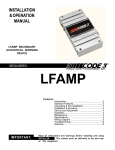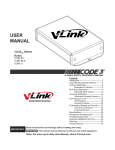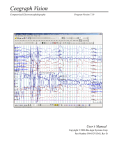Download Programmable control for siren and lights
Transcript
US 2013003 8444A1 (19) United States (12) Patent Application Publication (10) Pub. No.: US 2013/0038444 A1 (43) Pub. Date: Miller et al. (54) PROGRAMMABLE CONTROL FOR SIREN AND LIGHTS Publication Classi?cation (51) (75) Inventors: Daniel S. Miller, St. Louis, MO (US); Roger L. Miller, Louisville, KY (US); Daniel S. Pursley, St. Peters, MO (US); John C. Davis, Eureka, MO (US) (73) Assignee: CODE 3, INC., St. Louis, MO (US) Feb. 14, 2013 (52) Int. Cl. B60Q 1/52 (2006.01) H04R 27/00 (2006.01) B60Q 1/00 (2006.01) U.S. Cl. ......................... .. 340/455; 340/471; 381/82 (57) ABSTRACT A system comprising a poWer supply, an emergency Warning light and a speaker, in combination With a control head. One or more processors controls operation of the system in response to received user input and provides system status for display. Storage media encoded With emergency Warning (21) Appl. No.: 13/478,753 light system instructions for execution by one or more of the (22) Filed: processors controls the actuation of the emergency Warning May 23, 2012 light system and controls light patterns generated by the emergency Warning light system. The storage media is further Related U.S. Application Data (60) Provisional application No. 61/489,581, ?led on May encoded With siren system instructions for execution by one or more of the processors for controlling the actuation of the siren system and for controlling audible sounds generated by the siren system. 24, 2011. MANUAL 120 AIFI HEIHN eneral Configuration [Load Manager] he Load Manager allows the user to set up three parate Dropout Voltage Groups. ach group can be set to drop out individual outputs he input voltage to the Z3 Siren falls below the oup Voltage Fault Threshold. he input voltage must remain below the Group I outputs will remain off as long as the input voltage the Z3 Siren remains below the Group Voltage ult Threshold. Patent Application Publication Feb. 14, 2013 Sheet 1 0f 11 v: /7 wow // Awvmo Now // 4<ZEMPX NEPDQO O:PEOQ US 2013/0038444 A1 Patent Application Publication Feb. 14, 2013 Sheet 2 0f 11 mhzmu US 2013/0038444 A1 :5E$m65:5U.i0:; IEEg s ii 452.“: .QE4; :2m2.: Patent Application Publication Feb. 14, 2013 Sheet 4 0f 11 mE.2$:26mm9.:_2“ma3,532.32.En1_5 E22.5E0Q5E.S .52. 0?.0E :2m3.: 09. US 2013/0038444 A1 Patent Application Publication Feb. 14, 2013 Sheet 5 0f 11 US 2013/0038444 A1 $591sumEm.IP64.Sm_9,w>ami.n_. mhzu GE Patent Application Publication Feb. 14, 2013 Sheet 6 0f 11 FIG. 2 ,7 206 mmmuummmm 200 i.\ w... . .w p. 4:‘mm w?i.z US 2013/0038444 A1 Patent Application Publication Feb. 14, 2013 Sheet 7 0f 11 US 2013/0038444 Al 4MOo0<13Fw2hI0 N.OEmww um 0m wow 05 MaQ3mid0?2 .wwzmmwmwv m.QE EQ50m:<86o2m3: m;m| >mj mOEZO: IPDmkOFAZ Patent Application Publication Feb. 14, 2013 Sheet 8 0f 11 VOLTAGE SPEAKER BATT REGULATOR OUTPUT 401 402 sENsE CURRENT 404 US 2013/0038444 A1 / 407 ,/ SPEAKER _ DRIVER CIRCUIT 406 vEHICLE IGNITION 40a 407 SLEEP TIMER 410 4-m MICROPROCEssOR SUB-MODULE 500 FOR 12C __ ’ THE AMPLIFIER MODULE USB, (SEE FIG- 5) ‘2) 434 VEHICLE AE IN PARK SWITCH 412 REMOTE svvITCH DC E5350}? 414 CIRCUIT 43o HORN ssl'ggH DIGITAL POT 416 INTERCLEAR CIRCUIT 41s RRB OR MIC sIGNAL MIC CONTROLLED CONDITION svvITcH CIRCUIT 422 424 AMP —- 426 428 W L INPUTS FROM CONTTZL HEAD 9 MIC INPUTS FROM CONTROL HEAD 420 CIRCUIT FIGI 4 Patent Application Publication Feb. 14, 2013 Sheet 9 0f 11 US 2013/0038444 A1 I/O PORTS 532 ANALOG TONE -- TIIvIER CIRCUIT 524 I D FLIP FET(s) CIRCUIT _|--- TO SPEAKER(S) FLOP II P RT = HOEEITRQAY DIGITAL TONE ‘ INTERCLEAR RRB EN MmROPROCEsSOR 502 PTI' EN gié??g?lg‘g; HOLD ON MODULE 522 I n0 PORTS 530; [2C DATA SAE M708 POWER EN COMM REMOTE CIRCLHT 520 PARK KILL HORN RING SIREN EN q PTT I L CLOCK u OX RESET use COMM CIRCUIT 51s MOSFET FEDSRPT CLOCK 506 510 _ TEMPERATURE SENSORS 514 ICC OvERvOLTAGE CIRCUIT 508 528 526 NO 512 FIG. 5 ALARNI IGNITI N 0 Patent Application Publication Feb. 14, 2013 Sheet 11 0f 11 US 2013/0038444 A1 PUSH BUTTON CIRCUIT 726 BACKL7§HTWG FOR AUX A-H, PA MIC DIM, vvAIL, YELP CONNECTOR & ALT TONE 70a CONTROL HEAD COMM CONNECTOR 706 SAE M708 COMM CIRCUIT 724 — INTERNAL PIEzO BUZZER CIRCUIT 722 7 0 MICROPRLOZCESSOR PUSH BUTTON CONTROLLING ARggvg?lTT'cK THE CONTROL HEAD MODULE 72o LEvEL MICROPROCESSOR PROGRAMMING — __ 'ND‘CATORS 718 CONNECTOR 710 LEVEL 1-3 SWITCH _ CIRCUIT FIG 7 I PUSH BUTTON CIRCUIT FOR MANUAL & AIR HORN 714 ARROvvsTICK SIMULATOR 716 Feb. 14, 2013 US 2013/003 8444 Al PROGRAMMABLE CONTROL FOR SIREN AND LIGHTS BACKGROUND [0001] The technology described in this patent document generally relates to a system for controlling sirens and Wam ing lights in a motorized vehicle and, in particular, to a pro grammable control system for a siren and Warning lights in a motorized vehicle. SUMMARY [0002] Systems and methods are described herein for con trolling a siren and Warning light system in a motorized Warning light system instructions for execution by one or more of the processors controls the actuation of the emer gency Warning light system and controls light patterns gen erated by the emergency Warning light system. The storage media further encoded With siren system instructions for execution by one or more of the processors controls the actua tion of the siren system and controls audible sounds generated by the siren system. [0009] In another example, a system is provided for con trolling the use of an emergency Warning light and for con trolling the use of a siren in a motorized vehicle. A user control panel receives user input and displays system status. One or more processors controls operation of the system in response to received user input and provides system status for vehicle. In one example, a system is provided for use With a display. Storage media encoded With system instructions for poWer supply of a vehicle, an emergency Warning light and a execution by one or more of the processors controls the actua speaker. The system includes an ampli?er module, a light module and a control module. The ampli?er module has an tion of and the pattern provided through the emergency Warn ing light and controls the actuation of and the audible sounds input receiving poWer from the poWer supply and has outputs for selectively energizing the emergency Warning light and for selectively energizing the speaker. The ampli?er module may have one or more of the following: has an ampli?er module processor controlling the outputs of generated by the siren. Alternatively or in addition, the system [0010] Wherein When a push-to-talk (PTT) function is ampli?er module. The ampli?er module processor has a com activated for providing audio via a speaker, one or more of the processors resets the PTT function after a preset munications port. The light module has an input receiving poWer from the poWer supply and has outputs for controlling the emergency Warning light. The light module has a light module processor communicating the ampli?er module and controlling the outputs of the light module. The light module period of being activated so that the reset returns the system to its previous condition even though the PTT function continues to be active thereby avoiding a sys tem operation in Which the PTT function is activated processor has a communications port. A communications link [0011] one or more of the processors is programmed to implement a con?gurable poWer manager function or a connects the ampli?er module communications port to the light module communications port. The control head con nected to the ampli?er module processor controls the ampli ?er module and controls the light module processor via the ampli?er module processor and via the communications link. [0003] In another example, a method is provided for use With a poWer supply, an emergency Warning light and a speaker. The example method comprises: [0004] providing an ampli?er module having an input receiving poWer from the poWer supply and having out puts for selectively energizing the emergency Warning light and for selectively energizing the speaker, the ampli?er module having an ampli?er module processor controlling the outputs of ampli?er module, the ampli ?er module processor having a communications port; [0005] providing a light module having an input receiv ing poWer from the poWer supply and having outputs for controlling the emergency Warning light, the light mod ule having a light module processer communicating With the ampli?er module and controlling the outputs of the light module, the light module processor having a communications port; [0006] providing a communications link connecting the ampli?er module communications port to the light mod ule communications port; and beyond the preset period; con?gurable load manager function; [0012] one or more of the processors is programmed to implement monitoring voltages or currents of compo nents and includes de-energizing a component having a monitored voltage or a monitored current outside a pre set range; [0013] one or more of the processors is programmed to implement monitoring current or voltage of the poWer supply and includes dropout voltage groups Wherein a user selects one or more groups of outputs of the system to de-energize When the poWer supply levels fall beloW a speci?ed voltage level for each selected group; and/ or [0014] Wherein one or more of the processors imple ments a load manager function and a con?gurable delayed shutoff function Wherein the load manager When con?gured controls the poWer to other equipment in the vehicle through an external solenoid and Wherein the con?gurable delayed shutoff function When con?g ured includes a sleep delay timer such that the system remains active after the vehicle ignition is turned off for the duration of the sleep delay timer. BRIEF DESCRIPTION OF THE DRAWINGS AND APPENDICES [0007] controlling the ampli?er module and controlling the light module processor via the ampli?er module processor and via the communications link. [0008] In another example, provided is a system for con trolling the use of an emergency Warning light system and for controlling the use of a siren system in a motorized vehicle. A user control panel receives user input and displays system status. One or more processors control operation of the sys tem in response to received user input and provide system status for display. Storage media encoded With emergency [0015] FIG. 1 is a block diagram of another example system for controlling the actuation of a Warning light system and siren in a motorized vehicle. [0016] FIGS. 1A-1D are example screen shots of the con trol panel for con?guring an example ampli?er module. [0017] FIG. 2 is an illustration of the display of an example control head, lined for color. The toggle sWitch and. the left section of the faceplate of the control head are lined for the color red, the center section of the faceplate of the control US 2013/003 8444 Al head is lined for blue, and the upper right section of the faceplate of the control head is lined, for yelloW (e.g., amber). [0018] FIG. 3 is a block diagram ofan example system for controlling Warning lights and a siren. [0019] FIG. 4 is a block diagram of an example ampli?er module. [0020] FIG. 5 is a block diagram of an example micropro cessor sub-module for the example ampli?er module. [0021] FIG. 6 is a block diagram ofan example light mod ule. [0022] FIG. 7 is a block diagram of an example control head module. [0023] APPENDIX 1 illustrates FUNCTIONS CON Feb. 14, 2013 and/or storage media 110 that may be stored in the storage media 110. Data and/or instructions passed by the external computer 114 may be used by the processor (s) 108 to con ?gure the system 100. The instructions may include monitor ing instructions for detecting a system, setting Which is out side a reference range, above a maximum and/or beloW a minimum. Among other features, the monitoring instructions may control the system and/ or provide a Warning to the user When a system setting is outside the reference range. For example, FIG. 1A illustrates a screen 120 Which alloWs a user to select the load management settings, such as under-voltage and over-voltage thresholds, among other setting discussed herein. FIG. 1B illustrates a screen 140 Which alloWs a user to TROLLED BY AMPLIFIER MODULE processor of an select the siren lock settings, among other setting discussed example system. herein. FIG. 1C illustrates a screen 160 Which alloWs a user to [0024] APPENDIX 2 illustrates FUNCTIONS CON select the California Title 13 settings (CA T 13), among other TROLLED BY CONTROL HEAD MODULE PROCES setting discussed herein. FIG. 1B illustrates a screen 180 Which alloWs a user to select function settings for a 3-level SOR of an example system. [0025] APPENDIX 3 illustrates FUNCTIONS CON TROLLED BY LIGHT MODULE PROCESSOR of an example system. [0026] APPENDIX 4 illustrates Siren System Platform Z3TM Siren System Technical Speci?cation of an example system. [0027] APPENDIX 5 illustrates a HardWare Installation and Operation Manual of an example system. [0028] APPENDIX 6 illustrates a HardWare Quick Install Manual of an example system. [0029] APPENDIX 7 illustrates a Quick Start SoftWare Con?guration Setup Manual of an example system. [0030] APPENDIX 8 illustrates a Software User Manual of toggle sWitch 182 (see also 202 of FIG. 2), among other setting discussed herein. [0036] The storage media 110 may also be encoded With operating options instructions that When executed by one or more of the processors 108 causes the system 100 to receive operating options data over the I/O port 112. The operating options data, When interpreted by one of the processors 108 executing the operating options instructions, causes the sys tem to make available for user selection via the user control panel 106 (e.g., a control head module 700) a subset of avail able system operating options. The subset of system operat ing options corresponds to the operating options data. [0037] Tangible computer readable media 116 encoded an example system. [0031] Corresponding reference characters indicate corre With computer executable con?gurable instructions may also sponding parts throughout the draWings. con?gurable instructions When executed by the external com puter 114 may alloW the external computer to provide moni toring instructions to the processor (s) via the I/O port 112. The monitoring instructions may cause the system 100 to monitor a system setting, to detect When the system setting is DETAILED DESCRIPTION [0032] FIGS. 1A-1D are example screen shots of displays presented by softWare for con?guring an ampli?er module. Many parameters of the example system may be speci?ed by the user, some of Which have limited ranges, minimums and/ or maximums. Example settings and their purpose are dis cussed beloW and Within the Appendices. [0033] FIG. 1 is a block diagram ofan example system 100 for controlling the actuation of a Warning light system 102 and siren system 104 in a motorized vehicle such as an emer be provided for use With the external computer. The user outside a reference range and/or to provide a Warning indica tion via the user control panel 106 When the system setting is outside the reference range. [0038] The storage media 110 may also be encoded With load management instructions. When the load management instructions are executed by the processor(s), the system 100 monitors system input voltage from a vehicle battery, detects gency vehicle. The example system 100 includes a control panel 106, one or more processors 108, storage media 110, and an input/output (I/O) port 112, such as a USB or other port. The control panel 106 may be used to receive user input, When the system input voltage is outside a system input for example via push buttons, sWitches, touchpad, etc., and [0039] FIG. 2 is an example control head 200, lined for color. In this example, a toggle sWitch 202 and a left section 204 of a faceplate of the control head 200 are red to indicate to the user that the control buttons and toggle sWitch located in the left portion of the control head control a siren. The left section 202 is lined for the color red. A center section 206 of the faceplate of the control head 200 is blue to indicate to the user that the control buttons located in the center section 206 of the control head control the auxiliary buttons Which control a light bar and/or other devices on the vehicle. The center section 206 is lined for the color blue. A right section 208 of may be used to display system status. [0034] The processor(s) 108 execute programming instruc tions stored on storage media 110 to control the operation of the system, such as the actuation of the Warning light system and the light patterns generated by the Warning light system, in response to received user input and to provide system status for display by the control panel 106. The processor(s) 108 also execute other programming instructions stored on stor age media 110 to control other operations of the system, such as executing programming instructions for controlling the actuation of the siren system and for controlling audible voltage reference range and/or provides a Warning indication via the user control panel 106 When the system input voltage is outside the system input voltage reference range. the faceplate of the control head 200 is lined for amber (e. g., sounds generated by the siren system. yelloW) to indicate to the user that the control buttons located [0035] The I/O port 112 may be used by an external com puter 114 to pass instructions or data to the processor (s) 108 in the right portion of the control head control the traf?c directing equipment. The right section 208 is lined for the Feb. 14, 2013 US 2013/003 8444 Al color amber (yellow). A backlight control button for control ling dimming of a backlight for the control head 200 may also be positioned Within the right section 208. It activates the provide any one or more of the functions illustrated and any DIM output on the control head. This DIM output Would be connected to the light source for the control head, or other processors. Also, the example system of FIG. 1 may perform lighting equipment that has a DIM input control. This alloWs the user to place the backlighting of the control head 200 and/or other lighting equipment into a DIM mode of opera tion. [0040] Thus, the example control head includes three con trol groups presented to an operator: a ?rst control group for one or more of the processors may have any one or more of the inputs and/or outputs instead of or in addition to the other any one or more of the functions illustrated With regard to FIGS. 4-7 and may have any one or more of the inputs and/ or outputs illustrated in FIGS. 4-7. [0043] FIG. 4 is a block diagram of some of the various inputs and outputs of an example ampli?er module 400. The module 400 is connected to a vehicle battery 401 (or other battery) via a voltage regulator 402 and also via a circuit 404 selectively controlling siren operation, a second control group for selectively controlling auxiliary operations, such as for sensing current (and/or voltage) supplied by the battery the emergency Warning lights of a vehicle, and a third control ers 407. An ignition input port 408 monitors the on/off con dition of the vehicle ignition. A softWare timer 410 in the ampli?er processor (see 502 in FIG. 5) is referred to as a sleep group for selectively controlling a tra?ic directing light and/ or emergency Warning lights. The ?rst control group includes the red toggle sWitch 202 and other sWitches having the faceplate 204 colored red. The second control group includes the sWitches having the faceplate 206 colored blue. The third control group has sWitches having the faceplate 208 colored amber (yelloW). [0041] FIG. 3 is a block diagram of another example system for controlling the actuation of a Warning light system and 401 to a speaker driver circuit 406 driving one or more speak timer. This sleep timer may be con?gured using the siren con?guration softWare. In one example, it may be set for instant off or for a 10 minute, 20 minute, 30 minute, one hour, tWo hour, or four hour delay. This delay is started When the processor 502 detects that the vehicle ignition is turned off through the ignition input 408. The sleep timer maintains poWer to the ampli?er, the control head and the light board siren system in a motoriZed vehicle such as an emergency until the delay expires. vehicle. In general, FIG. 3 illustrates the primary connections betWeen the modules of the example system: an ampli?er module 400 primarily for driving siren speakers, a light board module 600 for primarily driving an emergency Warning light [0044] A park sWitch input 412 monitors the status of the vehicle park sWitch. An additional remote sWitch I/O port 414 or an auxiliary device and a control head module 700 for controlling the operation of the siren and other connected devices (e.g., via a CAT 5 cable 306). Both the ampli?er module 400 and light bar module 600 receive poWer via cable connections to a battery (not shoWn), such as a vehicle battery. The light bar module 600 may have a dual cable connection to the battery so that three higher gauge cables instead of tWo loWer gauge cables can handle the current needs for driving the light bar. An internal communication cable 308 intercon nects processors of the modules 400, 600 to facilitate an I2C I/O (input/output) communication link betWeen the modules 400, 600 and to facilitate communication With the control head module, Which may connected to the ampli?er processor 400 via a CAT-5 SAE 11708 communications cable 310. [0042] Alternatively or in addition, some or all of the com munication link betWeen components may be direct Wired or Wireless, such as Wi-Fi. In one example, each module has a processor. In another example, a single processor may be used so that a communication link betWeen the modules and/or processors is not needed. In yet another example, one or more may be to connect to an independent control sWitch such as a foot sWitch (not shoWn). The ampli?er module 400 is pro grammed to execute a particular mode When receiving the appropriate signal via the remote sWitch input port 414. For example, When the foot sWitch is activated While the ampli?er is generating one of the primary tones, the ampli?er Would execute a particular mode, such as change the ampli?er tone from the primary tone to an override tone for approximately 7 to 8 seconds. It may also activate an InterClear output based on the con?guration settings. As used herein, Interclear is a user-actuated timed-circuit option that initially changes the tones of the siren and the pattern of the light signals as the vehicle approaches an intersection, and then returns the siren to normal operation after a pre-set interval. [0045] A horn ring I/O 416 monitors the status of a horn ring sWitch (not shoWn). The ampli?er module 400 is pro grammed to execute a particular mode When receiving the appropriate signal via the horn ring I/O 416. For example, When the horn ring is activated While the ampli?er is gener ating one of the primary tones, the ampli?er Would execute a particular mode, such as change the ampli?er tone from the primary tone to an override tone for approximately 7 to 8 seconds. It may also activate the InterClear output based on processors control operation of the system in response to received user input and provide system status for display. The the con?guration settings. An InterClear output 418 connects processors may be independent of each other so that a com munications link betWeen processors is not needed. In gen eral, a link or cable 308 betWeen storage media encoded With system instructions for execution by one or more of the pro that activate an InterClear Feature. The operation during the InterClear mode is preprogrammed by the user. InterClear may be activated in different Ways. For example, if the siren is cessors controls the actuation of and the pattern provided through the emergency Warning light and controls the actua tion of and the audible sounds generated by the siren. For convenience, the folloWing description of FIGS. 4-7 includes the example Wherein each module has a processor. The examples shoWn in FIGS. 4-7 may be modi?ed to include one or more processors. Also, FIGS. 4-7 shoW one example implementation of the various functions, inputs and outputs to an InterClear circuit Which connects to the device or circuit operating one of the three primary tones (Wail, yelp, alt tone) and the horn ring is con?gured for Hit-n-Go, the InterClear feature turns on When the vehicle horn ring is pressed and remains on for approximately 7 to 8 seconds. The siren also generates one of the secondary tones as con?gured. In one embodiment, a manual button can also turn on the InterClear output While it is pressed. The InterClear output can also be con?gured to operate as the LoadMGR output. This feature of the modules and the processors. Other example implemen disables the normal InterClear function and utiliZes the same tations may provide for any one or more of the processors to circuitry to provide a positive signal. This signal may be Feb. 14, 2013 US 2013/003 8444 A1 connected to a user supplied solenoid, or relay to poWer other components or a system When the voltage exceeds a prepro equipment Within the vehicle. The LoadMGR continues to grammed maximum, eg 15 volts. An external clock 510 may be connected to the microprocessor 502. An I2C I/O port 512 supply this output until the input voltage to the ampli?er drops beloW a con?gurable level or until the ignition is turned is connected to and communicates With a light board module off and the sleep timer expires. [0046] In one example implementation, the InterClear cir processor 602. In order to prevent overheating, port 514 monitors temperature sensors positioned adjacent MOSFETs 528 driving the siren speakers 407. Communications port 518 cuit is internally current limited to one (1) amp. If an appli cation requires higher currents, a poWer booster may be used. Also shoWn in FIG. 4 are the inputs 419, 420 from the micro phone Which are connected via the control head 700, includ ing a radio re-broadcast (RRB) and/or microphone signal is connected to a USB communication interface such as an MCP2200 for connecting to a USB port of an external com puter (e.g., laptop or desktop) to program the processor 502 Which controls the ampli?er module 400. Port 520 connects conditioning circuit 422. There is also a microphone con trolled sWitch 424 Which is connected to a digital potentiom eter 426 and an ampli?er circuit 428 to control volume. The to the control head 700 via an SAE J 1708 circuit such as a digital potentiometer 426 is controlled by via the I2C port 434 to adjust the volume during PTT/PA (push-to-talk/public 524 controlled by and responsive to the microprocessor 502, or by a digital tone signal 522 generated by the microproces DS36277 transceiver. Digital and analog tones to the siren speakers are provided by either an analog tone timer circuit address) and RRB (radio re-broadcast) operation. During sor 502, via a ?ip-?op 526 and a MOSFET circuit 528 driving PTT/PA and RRB operation, an operator may adjust the vol ume setting and the adjusted setting is stored in memory. the speaker(s). [0060] Input/Outputs to/from the microprocessor 502 Thus, the ampli?er microprocessor sub-module 500 (e.g., microprocessor 502) stores in memory the previous digital include an I2C data port for communicating With a light module processor 602, a SIREN EN port for enabling the volume control setting during each of PTT/ PA and RRB operation and sets the potentiometer 426 at the previous set ting the next time PTT/PA or RRB operation is actuated by the by the siren, a PTT port for monitoring the push-to-talk operator. Also part of the related connections are a circuit 430 controlling a DC bias of the audio circuit and a voice input 432 (audio poWer is indicated as VAP). [0047] The module 400 includes several I/O ports 434 for communication including an I2C port for communicating With the light board module 600, an SAE 11708 port for communicating With the control head 700 and a programming port for communication With a USB port of a computer hav ing softWare for programming the processor 502 of the ampli ?er module 400. [0048] FIG. 5 is a block diagram of an example micropro cessor sub-module for the ampli?er module 400. In this example, the microprocessor 502 for the ampli?er module 400 is a PIC 16F887-E/PT processor although other proces sors may be used. Input/output (I/O) ports 504 include one or more of the folloWing: [0049] FET ENito enable/ disable siren output FETs 528 to the siren speakers; [0050] HORN RELAYito enable/ disable the vehicle horn; [0051] INTERCLEARito control InterClear feature output; [0052] RRS ENito enable/disable the RRB audio sig nal from going through the controlled sWitch 424; [0053] PTT ENito enable/disable the PA audio signal from going through the controlled sWitch 424; [0054] HOLD ONito hold poWer to the ampli?er, the light board and the control head until the vehicle ignition is off and the sleep timer has expired; [0055] POWER ENito sWitch siren speaker output from full to reduced poWer out; [0056] REMOTEito monitor an external remote sWitch; [0057] PARK KILLito monitor the park sWitch; and [0058] HORN RINGito monitor the status of the horn ring sWitch. [0059] An ICSP port 506 is an in-circuit serial program ming port for programming the microprocessor 502. The short circuit current sense circuit to alloW for tone generation sWitch on the microphone, a I2C CLOCK port for generating the clock pulses for I2C communications, a VOX port for monitoring voice, a RESET port that may be connected to ground for resetting the microprocessor 502 to factory default con?guration, an ALARM port for sensing a user supplied monitor (such as a canine temperature sensor), and/or an IGNITION port for monitoring When the ignition is on or off). [0061] In one example implementation, the system includes computer executable diagnostic instructions stored on a tangible computer readable media and executable by the ampli?er module processor 502 for detecting one or more of the folloWing system faults: [0062] A con?guration failure in Which ampli?er mod ule 400 fails to successfully load con?guration data at poWer up Wherein in response to the con?guration fail ure, the control head lights blink and a pieZo buZZer sounds to visually and audibly signal an operator; [0063] A communication failure in Which the control head and ampli?er module 400 are unable to establish data communications therebetWeen, Wherein in response to the communication failure the control head signals the operator (e. g., visually and/ or audibly) until communication is established; and [0064] A bloWn fuse or no output voltage Wherein in response to the bloWn fuse or no output voltage the control head signals the operator (e.g., audibly or via a ?ashing light). [0065] In one example implementation, the ampli?er mod ule processor 502 implements programmable multiple siren tone sets responsive to activation of the folloWing on the control head: [0066] A WAIL push-button so that the microprocessor 502 generates a Wail tone via speakers 407 When the WAIL push-button is pressed; [0067] AYELP push-button so that the microprocessor 502 generates a yelp tone via speakers 407 When the YELP push-button is pressed; [0068] A ALT TONE push-button so that the micropro microprocessor is connected to an overvoltage circuit 508 for cessor 502 generates the Hi-Lo tone via speakers 407 monitoring the applied voltage and selectively shutting doWn When the ALT TONE push-button is pressed; and Feb. 14, 2013 US 2013/003 8444 A1 [0069] A MANUAL push-button so that the micropro cessor 502 generates a MANUAL Wail tone via speakers lator circuit 716 on the face of the control head is driven by the processor 702 to indicate that the tra?ic directing signal is 407 When the MANUAL push-button is pressed. illuminating a move right pattern, a move left pattern, a move [0070] Usually, a PTT push-button is pressed on a micro phone to activate the PTT function. In one example imple mentation, the ampli?er module processor 502 resets the PTT function after a preset period (e. g., 30 seconds) of being held so that the reset returns to its previous condition even though the PTT push-button is still being held in the on position. This avoids the situation Where the PTT push-button is “stuck” in the ON position for extended periods, such as beyond the left or right pattern or a ?ash pattern. Three LEDs indicating the position of the toggle sWitch and thus the level of opera tion are connected at 718. The button controls for the ArroW stik® light are connected at 720. An internal audio device (e.g., pieZo buZZer or speaker) for the control head (e.g., to beep or sound alarms) is connected at 722. The push buttons for auxiliary A-H, dim, Wail, yelp and alternative tone on the face of the control head 700 are connected at 726. preset period. [0076] [0071] include a con?gurable light alert function in Which an audible In one example implementation, computer execut Optionally, the control head processor 702 may able instructions for providing a digital volume control are signal is generated on a periodic basis When any lighting is implemented by the ampli?er module processor 502 includ activated including auxiliary and traf?c directing lighting. ing separate and independent volume control for radio re [0077] broadcast (RRB) and public address (PA) transmissions of processors is programmed to implement a con?gurable audio provided by a microphone connected to the control head. The microphone has a PTT (press-to-talk) push-button poWer manager function or a con?gurable load manager func tion. For example, at least one of the processors is pro Which is also responsive to a volume adjustment mode for grammed to implement monitoring voltages or currents of components and includes de-energiZing a component having digitally adjusting the potentiometer 426 to adjust the vol In one example implementation, at least one of the ume. a monitored voltage or a monitored current outside a preset [0072] Optionally, the ampli?er module processor 502 may execute computer instructions broadcasting tWo-Way radio range. As another example, at least one of the processors is reception over the siren speakers 407 When a tWo -Way radio is programmed to implement monitoring current or voltage of the poWer supply and includes dropout voltage groups connected to an auxiliary port of the ampli?er module 400. Wherein a user selects one or more groups of outputs of the [0073] In FIG. 5, the other inputs and outputs to the ampli system to de-energiZe When the poWer supply levels fall ?er module 400 Which are illustrated in FIG. 4 are directly or beloW a speci?ed voltage level for each selected group. In one indirectly via circuits connected to the processor 502. These inputs and outputs are represented by I/O ports 532. [0074] FIG. 6 is a block diagram ofan example light mod embodiment, the preset range and/or the speci?ed voltage level are each con?gurable by the user via a USB port con nected to one of the processors. Altematively or in addition, a ule 600. In this example, the microprocessor 602 for an emer gency Warning light, such as a light bar, may be any processor having serial and parallel ports, such as a PIC 16F887-E/PT processor. The microprocessor 602 interfaces With poWer delay may be speci?ed before a group is dropped out. [0078] In one example implementation, at least one of the processors implements a user con?gurable input voltage stabiliZation circuitry 604 for controlling the voltage applied to the light bar. A light bar parallel communication port 606 from the poWer supply is monitored and one or more opera tions are disabled When the input voltage is outside a user connects to a centrally controlled light bar (i.e., an emergency con?gurable range. Warning light), to control the light bar. An ArroWstik® tra?ic [0079] In one example implementation, at least one of the processors includes a lock function selectable at con?gura tion such that a remote input activates the lock function alloW directing light communication parallel port 698 controls the tra?ic directing device. An ICSP port 610 permits in circuit serial programming (ICSP). An external clock 612 is con nected to the processor 602. An I2C I/ O port 613 is connected to and communicates With the ampli?er processor via port 512. A CC ArroWstik connector 614 is for operating centrally controlled. ArroWstik® light products. An IC 616 is con nected to the processor 602 to control the auxiliary circuits E-H 618, 619. Also, solid state relays 620 connect to the processor to control the level 1-3 connector circuit 624 and the auxiliary circuitsA-D 622. Ports 626, 628 also monitor the monitoring and dropout function in Which an input voltage ing only alloW siren tones to be generated via the speakers When a signal (positive or negative as set in con?guration) is applied to the remote input. This function meets certain requirements of the European Union. [0080] In one example implementation, at least one of the processors includes a user con?gurable function Which When [0075] FIG. 7 is a block diagram of an example control head module. In this example, the microprocessor 702 for the activated by the user disables speaker Alt Tone functions and disables speaker Air Horn functions When any tone or light is active. This function meets certain requirements of California Title 13. [0081] In one example implementation, at least one of the control head may be a PIC 16F887-E/ PT processor. The processors implements a load manager function and/ or a con microprocessor 702 interfaces With a backlighting circuit 704 712 (e.g., the red toggle sWitch) and the push buttons for ?gurable delayed shutoff function Wherein the load manager When con?gured controls the poWer to other equipment in the vehicle through an external solenoid. The con?gurable delayed shutoff function When con?gured includes a sleep delay timer such that the system remains active after the vehicle ignition is turned off for the duration of the sleep delay timer. [0082] The load manager function and/ or the delayed shut off function control the poWer supplied to other loads in the manual siren and air horn operation 714. An ArroWstik simu vehicle such that the poWer to these other loads are turned off auxiliary A-F fuses and the level 1-3 fuses, respectively. to dim the LED lighting for the ?ash, left, center, right, manual and air horn push buttons on the control head (FIGS. 1A-1D, 2). A control head communication connector 706 connects to the SAE port of the ampli?er microprocessor 502 via an SAE circuit 724 and to the PA microphone via connec tor 708. A connector 710 provides a programming input to the processor 702, Which also connects level 1-3 sWitch circuit Feb. 14, 2013 US 2013/003 8444 Al when the user turns off the vehicle ignition and/ or the voltage of the battery for the vehicle has dropped below a predeter mined voltage level. [0083] For purposes of illustration, programs and other executable program components, such as the operating sys is contemplated that executing or performing a particular operation before, contemporaneously with, or after another operation is within the scope of the example implementa tions. [0089] When introducing elements of example implemen tem, are illustrated herein as discrete blocks. It is recognized, tations, the articles “a,” “an,” “the,” and “said” are intended to however, that such programs and components reside at vari ous times in different storage components of the computer, and are executed by the data processor (s) of the computer. [0084] Although described, in connection with an exem mean that there are one or more of the elements. The terms plary computing system environment, example implementa [0090] Not all of the depicted components illustrated or described may be required. In addition, some example imple tions are operational with numerous other general purpose or special purpose computing system environments or con?gu rations. The computing system environment is not intended to suggest any limitation as to the scope of use or functionality “comprising,” “including,” and “having” are intended to be inclusive and mean that there may be additional elements other than the listed elements. mentations may include additional components. Variations in the arrangement and type of the components may be made without departing from the spirit or scope of the claims as set forth herein. Additional, different or fewer components may of any aspect of the invention. Moreover, the computing system environment should not be interpreted as having any be provided and components may be combined. Alternatively dependency or requirement relating to any one or combina or in addition, a component may be implemented by several tion of components illustrated in the exemplary operating environment. Examples of well-known computing systems, components. [0091] The above description illustrates the invention by environments, and/ or con?gurations that may be suitable for way of example and not by way of limitation. This description use with aspects of the invention include, but are not limited enables one skilled in the art to make and use the invention, to, personal computers, server computers, hand-held or lap and describes several example implementations, adaptations, top devices, multiprocessor systems, microprocessor-based variations, alternatives and uses of the invention, including what is presently believed to be the best mode of carrying out the invention. Additionally, it is to be understood that the invention is not limited in its application to the details of construction and the arrangement of components set forth in systems, set top boxes, programmable consumer electronics, mobile telephones, network PCs, minicomputers, mainframe computers, distributed computing environments that include any of the above systems or devices, and the like. the general context of data and/or computer-executable the following description or illustrated in the drawings. The invention is capable of other example implementations and of instructions, such as program modules, stored one or more being practiced or carried out in various ways. Also, it will be tangible computer storage media and executed by one or more computers or other devices. Generally, program modules include, but are not limited to, routines, programs, objects, understood that the phraseology and terminology used herein [0085] The example implementations may be described in components, and data structures that perform particular tasks or implement particular abstract data types. Example imple mentations may also be practiced in distributed computing is for the purpose of description and should not be regarded as limiting. [0092] Having described aspects of the invention in detail, it will be apparent that modi?cations and variations are pos environments where tasks are performed by remote process ing devices that are linked through a communications net work. In a distributed computing environment, program mod ules may be located in both local and remote computer sible without departing from the scope of aspects of the inven tion as de?ned in the appended claims. As various changes could be made in the above constructions, products, and methods without departing from the scope of aspects of the invention, it is intended that all matter contained in the above storage media including memory storage devices. description and shown in the accompanying drawings shall be [0086] In operation, computers and/ or servers may execute the computer-executable instructions such as those illustrated interpreted as illustrative and not in a limiting sense. herein to implement aspects of the invention. [0087] Examples may be implemented with computer-ex ecutable instructions. The computer-executable instructions may be organiZed into one or more computer-executable components or modules on a tangible computer readable storage medium. Examples may be implemented with any number and organization of such components or modules. For example, Example implementations are not limited to the speci?c computer-executable instructions or the speci?c components or modules illustrated in the ?gures and described herein. Other example implementations may include different computer-executable instructions or com ponents having more or less functionality than illustrated and described herein. [0088] The order of execution or performance of the opera tions in examples illustrated and described herein is not essential, unless otherwise speci?ed. That is, the operations may be performed in any order, unless otherwise speci?ed, and example implementations may include additional or fewer operations than those disclosed herein. For example, it What is claimed is: 1. A system for controlling the use of an emergency wam ing light and a speaker on a vehicle with a power supply, said system comprising: an ampli?er module having an ampli?er module processor for controlling the ampli?er module to selectively ener giZe the emergency warning light and to selectively energiZe the speaker, said ampli?er module processor having a communications port; a light module having a light module processor for control ling the ampli?er module and the emergency warning light, said light module processor having a communica tions port; a communications link connecting the ampli?er module communications port to the light module communica tions port; and a control head connected to the ampli?er module processor for controlling the ampli?er module and for controlling the light module processor via the ampli?er module processor and via the communications link. Feb. 14, 2013 US 2013/003 8444 Al 2. The system of claim 1 further comprising said light tion over siren speakers When a tWo -Way radio is connected to module having at least one of: a serial port for controlling a an auxiliary port of the ampli?er module. serial emergency Warning light and having a parallel port for controlling a centrally controlled emergency Warning light. 11. The system of claim 1 further comprising a light source for backlighting the control head Wherein an intensity or 3. The system of claim 1 Wherein the ampli?er module processor is con?gurable via a USB port. brightness of the light source is adjustable Wherein the control 4. The system of claim 3 further comprising computer head processor is responsive to a user to selectively dim the light source. executable user-con?gurable instructions stored on a tangible 12. The system of claim 1 further comprising solid state computer readable media, said con?guration instructions executable by a computer to provide monitoring instructions relays controlled by the ampli?er module processor for selec tively providing poWer to energiZe the emergency Warning to at least one of the processors via the USB port, said moni light and Wherein the light module processor is connected to toring instructions When executed by at least one of the pro cessors causing the system to detect a system setting Which is outside a reference range, said monitoring instructions for causing the system to provide a Warning to the user When a and controls the selective energiZing of the emergency Wam ing lights to create various patterns in response to user input via the control head. 13. The system of claim 1 Wherein the control head includes three control groups presented to an operator, a ?rst system setting is outside the reference range. 5. The system of claim 1 further comprising computer puter readable media, said diagnostic instructions executable control group for selectively controlling speaker operation, a second control group for selectively controlling auxiliary operations of the emergency Warning light and the speakers by the ampli?er module processor for detecting one or more and a third control group for selectively controlling a traf?c executable diagnostic instructions stored on a tangible com of the folloWing system faults: a con?guration failure in Which ampli?er module fails to successfully load con?guration data at poWer up Wherein in response to said con?guration failure, said ampli?er module implements a factory default con?gu ration; a communication failure in Which the control head and ampli?er module are unable to establish data communi cations therebetWeen, Wherein in response to said com munication failure the control head signals the operator until communication is established; and a bloWn fuse or no output voltage Wherein in response to said bloWn fuse or no output voltage the control head signals the operator. 6. The system of claim 5 Wherein the diagnostic instruc tions include load management instructions Which alloW the system to receive under-voltage and over-voltage thresholds from an operator. directing light and the emergency Warning light. 14. The system of claim 13 Wherein the ?rst control group includes a toggle sWitch and other sWitches having a faceplate colored red, Wherein the second control group includes sWitches having a faceplate colored blue, and Wherein the third control group has sWitches having a faceplate colored amber. 15. The system of claim 1 further comprising at least one of the following: Wherein at least one of the processors is programmed to implement a con?gurable poWer manager function or a con?gurable load manager function; Wherein at least one of the processors is programmed to implement monitoring voltages or currents of compo nents and. includes de-energiZing a component having a monitored voltage or a monitored current outside a pre set range; and 7. The system of claim 1 Wherein the ampli?er module Wherein at least one of the processors is programmed to processor is programmed to reset a PTT function after a preset audio via a speaker to prevent the PTT function from remain monitor a poWer supply voltage level and recogniZe dropout voltage groups selectable by a user and Wherein in response to the monitored voltage level falling beloW a speci?ed voltage level for a selected dropout voltage ing activated beyond the preset period. group, the processor is programmed to cause the period of time elapses after a PTT push-button is continu ously engaged to activate the PTT function for providing 8. The system of claim 1 Wherein the ampli?er module processor is programmed to execute instructions for generat ing a siren tone responsive to the engagement of each of the folloWing sWitches on the control head: A WAIL push-button Wherein the microprocessor gener ates a Wail tone via a siren speaker; A YELP push-button Wherein the microprocessor gener ates a yelp tone via a siren speaker; A ALT TONE push-button Wherein the microprocessor generates the Hi-Lo tone via a siren speaker; and A MANUAL push-button Wherein the microprocessor generates a manual Wail tone via a siren speaker. 9. The system of claim 1 further comprising instructions for execution by the ampli?er module processor for providing digital volume control including separate and independent selected dropout voltage group to become de-energiZed. 1 6. The system of claim 15 Wherein the preset range and the speci?ed voltage level are each selectable by a user via a USB port connected to one of the processors and Wherein a delay period must elapse before a group is de-energiZed. 17. The system of claim 1 Wherein the control head pro cessor is programmed to implement a light alert function in Which an audible signal is generated on a periodic basis When lighting, including auxiliary and tra?ic directing lighting, is activated. 18. The system of claim 1 Wherein at least one of the processors is programmed to implement a lock function selectable at con?guration Wherein a remote input activates the lock function alloWing only preset siren tones to be gen erated via the speakers When a signal is applied to the remote digital volume control for at least one of radio re-broadcast input. (RRB), push-to-talk (PTT) and public address (PA) transmis 19. The system of claim 1 Wherein at least one of the processors is programmed to implement a user con?gurable sions of audio. 10. The system of claim 1 Wherein the ampli?er module processor is programmed to broadcast tWo-Way radio recep input voltage monitoring and dropout function in Which an input voltage from the poWer supply is monitored and one or Feb. 14, 2013 US 2013/003 8444 Al more operations are disabled When the input voltage is out side a user con?gurable range. 20. The system of claim 1 Wherein at least one of the processors is programmed to implement a load manager func tion and a con?gurable delayed shutoff function Wherein the load manager When activated controls the poWer to other equipment in the vehicle through an external solenoid and Wherein the con?gurable delayed shutoff function When acti vated includes a sleep delay timer such that the system remains active after the vehicle ignition is turned off for the duration of the sleep delay timer. 21. The system of claim 20 Wherein the load manager function and the delayed shutoff function control the poWer supplied to other loads in the vehicle such that the poWer to these other loads are turned off When the user turns off the vehicle ignition or the voltage of the battery for the vehicle has dropped beloW a predetermined voltage level. 22. The system of claim 1 Wherein at least one of the processors is programmed to implement a user con?gurable function Which When activated by the user disables speaker Alt Tone functions and disables speaker Air Horn functions When any tone or light is active. 23. The system of claim 1 further comprising: a poWer supply; an emergency Warning light; and a speaker. 24. A method for use With a poWer supply, an emergency Warning light and a speaker, said method comprising: providing an ampli?er module having an input receiving poWer from the poWer supply and having outputs for selectively energiZing the emergency Warning light and for selectively energiZing the speaker, said ampli?er module having an ampli?er module processor control ling the outputs of ampli?er module, said ampli?er mod ule processor having a communications port; providing a light module having an input receiving poWer from the poWer supply and having outputs for control ling the emergency Warning light, said light module having a light module processor controlling the ampli ?er module and controlling the outputs of the light mod ule, said light module processor having a communica tions port; providing a communications link connecting the ampli?er module communications port to the light module com munications port; and controlling the ampli?er module and controlling the light module processor via the ampli?er module processor and via the communications link. 25. A system for controlling the use of an emergency Warn ing light and a speaker on a vehicle With a poWer supply, said system comprising: an ampli?er module to selectively energiZe the emergency Warning light and to selectively energiZe the speaker, said ampli?er module having a communications port; a light module to selectively energiZe the emergency Wam ing light, said light module having a communications Port; a communications link connecting the ampli?er module communications port to the light module communica tions port; and a control head connected to the ampli?er module for con trolling the ampli?er module and for controlling the light module via the ampli?er module and via the com munications link. 26. The system of claim 25 further comprising at least one of the folloWing: Wherein at least one of the modules resets a PTT function after a preset period of time elapses after a PTT push button is continuously engaged to activate the PTT func tion for providing audio via a speaker to prevent the PTT function from remaining activated beyond the preset period; Wherein at least one of the modules implements a con?g urable poWer manager function or a con?gurable load manager function; Wherein at least one of the modules monitors voltages or currents of components and includes de-energiZing a component having a monitored voltage or a monitored current outside a preset range; and Wherein at least one of the modules monitors a poWer supply voltage level and recogniZe dropout voltage groups selectable by a user and Wherein in response to the monitored voltage level falling beloW a speci?ed voltage level for a selected dropout voltage group, the module causing the selected dropout voltage group to become de-energiZed; and Wherein at least one of the modules implements a load manager function and a con?gurable delayed shutoff function Wherein the load manager When activated con trols the poWer to other equipment in the vehicle through an external solenoid and Wherein the con?gurable delayed shutoff function When activated includes a sleep delay timer such that the system remains active after the vehicle ignition is turned off for the duration of the sleep delay timer.























